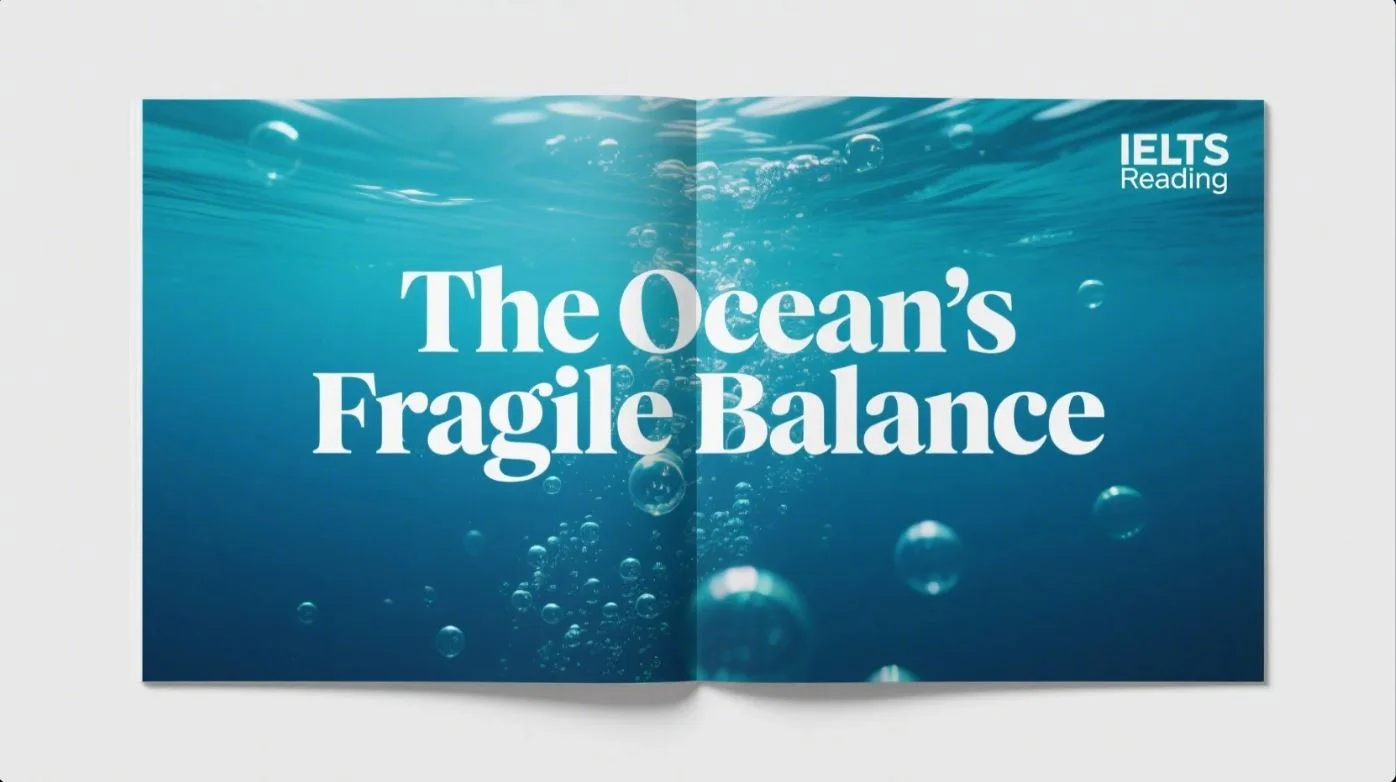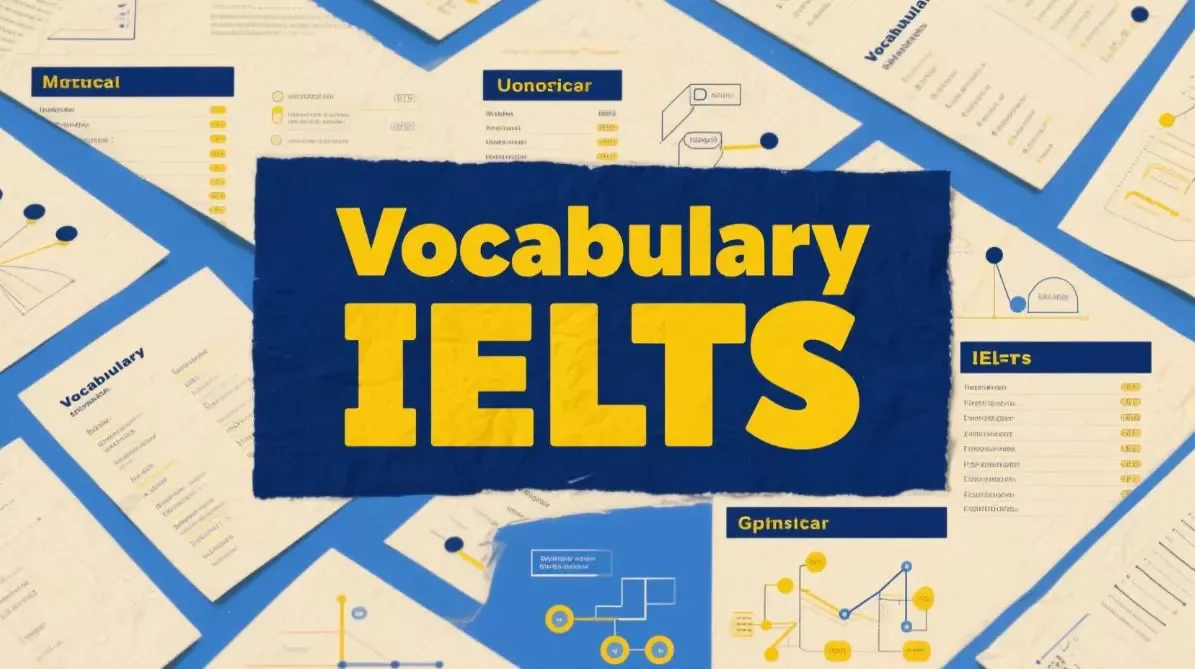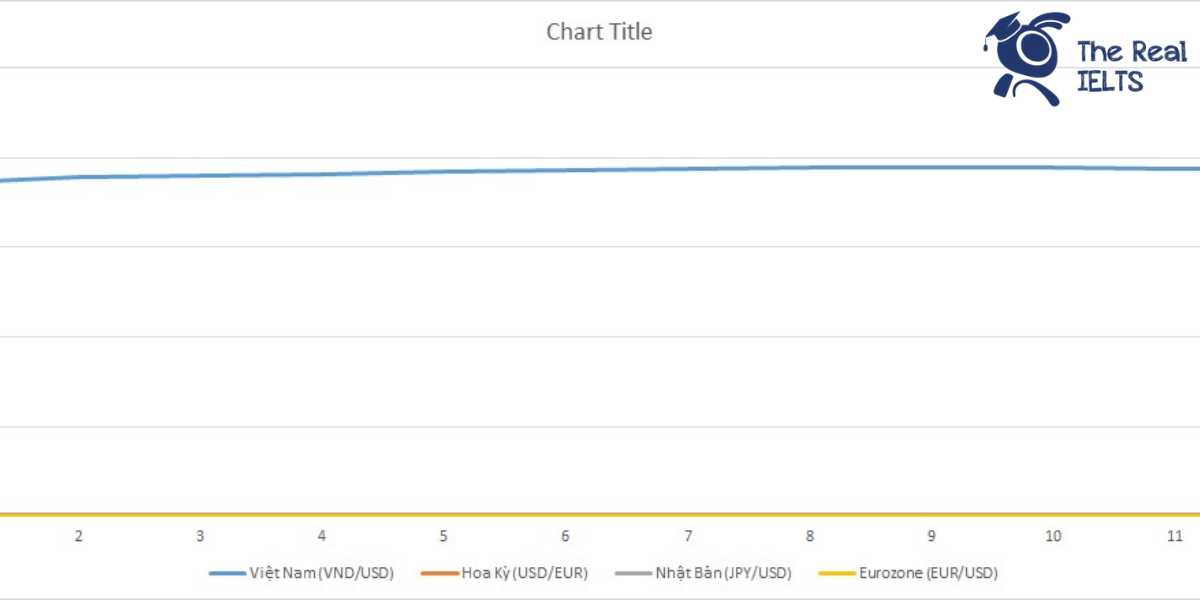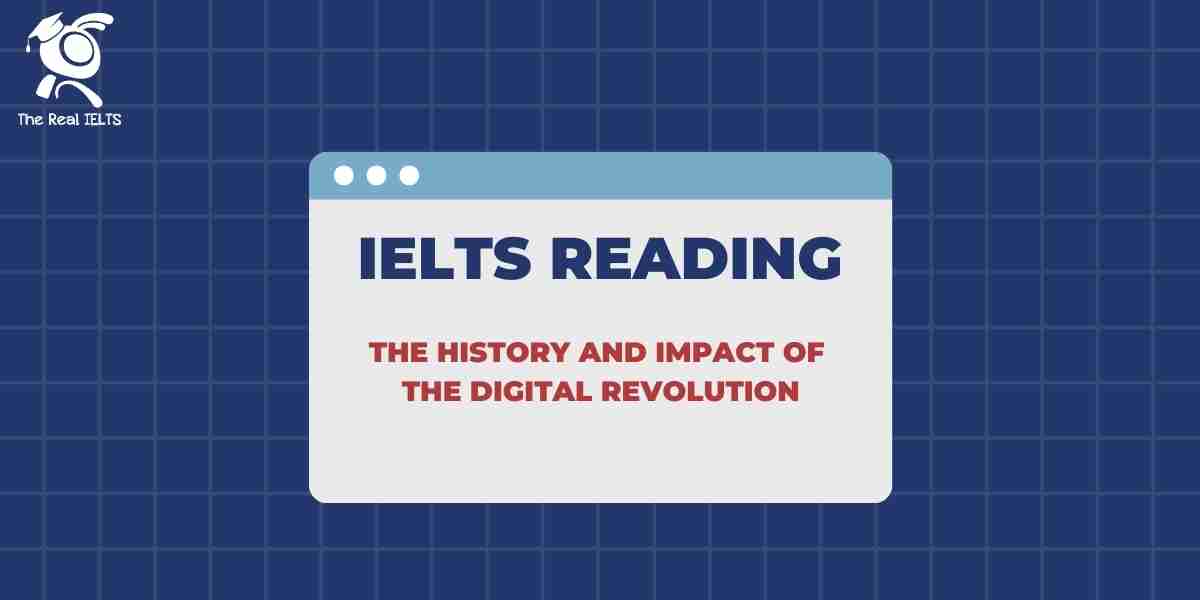Kỹ năng đọc hiểu trong IELTS là một thử thách đòi hỏi sự sắc bén và chiến lược rõ ràng để xử lý các văn bản học thuật phức tạp. IELTS Reading đánh giá khả năng nắm bắt ý chính, phân tích chi tiết và suy luận logic trong thời gian giới hạn. Với các đoạn văn đa dạng về chủ đề và độ khó tăng dần, thí sinh cần rèn luyện kỹ thuật đọc hiệu quả để tối ưu hóa điểm số và chinh phục mục tiêu band cao.
Đọc thêm: IELTS Reading Practice Test: Recycling and Waste Management
Marine Ecosystems: The Ocean’s Fragile Balance
Marine ecosystems, encompassing oceans, coral reefs, and coastal wetlands, are vital to global biodiversity and human survival. Oceans cover over 70% of Earth’s surface, hosting diverse species from microscopic plankton to massive whales. These ecosystems regulate climate by absorbing carbon dioxide and provide resources like fish, which support millions of livelihoods worldwide.
Coral reefs, often called the “rainforests of the sea,” house a quarter of all marine species despite occupying less than 0.1% of the ocean floor. They thrive in warm, shallow waters but face threats from climate change, such as rising sea temperatures and ocean acidification, which cause coral bleaching. Overfishing and pollution further degrade these fragile habitats.
Coastal wetlands, including mangroves and salt marshes, protect shorelines from erosion and serve as nurseries for fish. However, urban development and rising sea levels are reducing their extent. In 2023, reports indicated that 50% of global mangrove forests have been lost since the 1980s, impacting biodiversity and coastal communities.
Efforts to protect marine ecosystems include establishing marine protected areas (MPAs) and regulating fishing practices. Innovations like artificial reefs aim to restore damaged habitats, though their long-term success is uncertain. Public awareness is growing, but challenges remain due to the high costs of conservation and the global scale of threats. Sustaining marine ecosystems requires international cooperation to balance human needs with environmental preservation.
Câu hỏi
Questions 1–40
Question 1 (Multiple Choice)
What is a key role of marine ecosystems mentioned in the passage?
A. They prevent urban development.
B. They regulate the Earth’s climate.
C. They eliminate all ocean pollution.
D. They increase sea levels.
Question 2 (Multiple Choice)
Why are coral reefs compared to rainforests?
A. They cover a large area of the ocean.
B. They support a high diversity of species.
C. They are unaffected by climate change.
D. They are found in deep ocean waters.
Question 3 (True/False/Not Given)
Coral reefs occupy more than 1% of the ocean floor.
A. True
B. False
C. Not Given
Question 4 (True/False/Not Given)
Mangrove forests have increased in size since the 1980s.
A. True
B. False
C. Not Given
Question 5 (Yes/No/Not Given)
Does the passage suggest that marine ecosystems are essential for human survival?
A. Yes
B. No
C. Not Given
Question 6 (Yes/No/Not Given)
Are artificial reefs guaranteed to restore damaged marine habitats?
A. Yes
B. No
C. Not Given
Question 7 (Matching Information)
Which paragraph discusses the threats to coral reefs?
A. Paragraph 1
B. Paragraph 2
C. Paragraph 3
D. Paragraph 4
Question 8 (Matching Information)
In which paragraph is the loss of mangrove forests mentioned?
A. Paragraph 1
B. Paragraph 2
C. Paragraph 3
D. Paragraph 4
Question 9 (Matching Headings)
Choose the correct heading for Paragraph 1:
A. Threats to Marine Life
B. Importance of Marine Ecosystems
C. Conservation Efforts
D. Impact of Urban Development
Question 10 (Matching Headings)
Choose the correct heading for Paragraph 4:
A. Challenges and Solutions for Marine Conservation
B. The Role of Coral Reefs
C. Climate Change Impacts
D. Benefits of Coastal Wetlands
Question 11 (Matching Sentence Endings)
Coral reefs are vital because …
A. they cover most of the ocean floor.
B. they support a quarter of marine species.
C. they are immune to pollution.
D. they prevent rising sea levels.
Question 12 (Matching Sentence Endings)
Coastal wetlands are important but …
A. are threatened by urban development.
B. do not support marine life.
C. are unaffected by climate change.
D. increase ocean acidification.
Question 13 (Sentence Completion)
Oceans help regulate climate by absorbing _______.
Question 14 (Sentence Completion)
Coral bleaching is caused by rising sea _______ and ocean acidification.
Question 15 (Summary Completion)
Complete the summary using words from the passage:
Marine ecosystems, including oceans and coral reefs, support _______ and regulate the Earth’s climate.
Question 16 (Summary Completion)
Conservation efforts include establishing _______ to protect marine ecosystems.
Question 17 (Diagram Label Completion)
Label the diagram of a coral reef ecosystem:
The habitat known as the “rainforests of the sea” is called a _______ reef.
Question 18 (Diagram Label Completion)
Label the diagram of a coastal ecosystem:
The ecosystem that protects shorelines from erosion is called a _______ wetland.
Question 19 (Short Answer Questions)
What is one threat to coral reefs mentioned in the passage?
Question 20 (Short Answer Questions)
What percentage of global mangrove forests has been lost since the 1980s?
Question 21 (Table Completion)
Complete the table below with information from the passage:
| Ecosystem | Role | Threat |
|---|---|---|
| Coral Reefs | _____________ | Climate change |
| Coastal Wetlands | Protect shorelines | _____________ |
| Oceans | Regulate climate | _____________ |
Question 22 (Multiple Choice)
What is a challenge mentioned for marine conservation?
A. Lack of public awareness
B. High costs of conservation
C. Absence of international cooperation
D. Complete loss of marine species
Question 23 (True/False/Not Given)
Marine protected areas have fully restored all damaged ecosystems.
A. True
B. False
C. Not Given
Question 24 (Yes/No/Not Given)
Does the passage indicate that public awareness of marine conservation is increasing?
A. Yes
B. No
C. Not Given
Question 25 (Matching Information)
Which paragraph mentions the role of oceans in supporting livelihoods?
A. Paragraph 1
B. Paragraph 2
C. Paragraph 3
D. Paragraph 4
Question 26 (Matching Headings)
Choose the correct heading for Paragraph 2:
A. Benefits of Coastal Wetlands
B. Diversity and Threats to Coral Reefs
C. Global Conservation Strategies
D. Impact of Rising Sea Levels
Question 27 (Sentence Completion)
Coastal wetlands serve as _______ for fish.
Question 28 (Summary Completion)
Mangrove forests have been reduced by _______ since the 1980s, affecting biodiversity.
Question 29 (Short Answer Questions)
What is one conservation effort mentioned in the passage?
Question 30 (Diagram Label Completion)
Label the diagram of an ocean ecosystem:
The organisms that range from microscopic to massive are called _______.
Question 31 (Multiple Choice)
What is one resource provided by oceans according to the passage?
A. Urban development materials
B. Fish for livelihoods
C. Artificial reefs
D. Carbon dioxide emissions
Question 32 (True/False/Not Given)
Coral reefs are only found in deep ocean waters.
A. True
B. False
C. Not Given
Question 33 (Yes/No/Not Given)
Does the passage suggest that marine ecosystems can recover without international cooperation?
A. Yes
B. No
C. Not Given
Question 34 (Matching Sentence Endings)
Marine conservation faces challenges because …
A. ecosystems are not important to humans.
B. of the high costs and global scale of threats.
C. there is no public awareness.
D. artificial reefs are ineffective.
Question 35 (Sentence Completion)
Artificial _______ are an attempt to restore damaged marine habitats.
Question 36 (Summary Completion)
Complete the summary:
Marine ecosystems are threatened by climate change, _______ and urban development.
Question 37 (Short Answer Questions)
Name one type of coastal wetland mentioned in the passage.
Question 38 (Table Completion)
Complete the table below with information from the passage:
| Ecosystem | Example Species | Threat |
|---|---|---|
| Coral Reefs | Marine species | _________ |
| Oceans | _________ | Overfishing |
Question 39 (Multiple Choice)
What is a key feature of coastal wetlands mentioned in the passage?
A. They increase ocean acidification.
B. They serve as nurseries for fish.
C. They cover most of the ocean.
D. They are unaffected by rising sea levels.
Question 40 (True/False/Not Given)
All marine ecosystems are completely protected from human activities.
A. True
B. False
C. Not Given
Đáp án và Giải thích
Question 1
Correct Option: B
Explanation: Bài đọc nêu rằng hệ sinh thái biển “regulate climate by absorbing carbon dioxide.” Lựa chọn B đúng vì nó đề cập đến vai trò chính này. Các lựa chọn khác không chính xác hoặc không được đề cập.
Question 2
Correct Option: B
Explanation: Bài đọc so sánh rạn san hô với rừng mưa vì chúng “house a quarter of all marine species,” thể hiện sự đa dạng loài cao. Lựa chọn B đúng, các lựa chọn khác mâu thuẫn với bài đọc.
Question 3
Correct Option: B
Explanation: Bài đọc nêu rằng rạn san hô chiếm “less than 0.1% of the ocean floor.” Do đó, câu nói chúng chiếm hơn 1% là sai.
Question 4
Correct Option: B
Explanation: Bài đọc nêu rằng “50% of global mangrove forests have been lost since the 1980s.” Câu nói rừng ngập mặn tăng kích thước là sai.
Question 5
Correct Option: A
Explanation: Bài đọc đề cập rằng hệ sinh thái biển “vital to global biodiversity and human survival,” xác nhận rằng chúng cần thiết cho sự sống còn của con người. Đáp án là “Yes.”
Question 6
Correct Option: B
Explanation: Bài đọc nêu rằng “the long-term success” của rạn san hô nhân tạo “is uncertain,” ngụ ý chúng không được đảm bảo khôi phục hoàn toàn. Đáp án là “No.”
Question 7
Correct Option: B
Explanation: Các mối đe dọa đối với rạn san hô, như nhiệt độ biển tăng và axit hóa đại dương, được thảo luận ở đoạn 2: “face threats from climate change, such as rising sea temperatures and ocean acidification.”
Question 8
Correct Option: C
Explanation: Sự mất mát của rừng ngập mặn được đề cập ở đoạn 3: “50% of global mangrove forests have been lost since the 1980s.”
Question 9
Correct Option: B
Explanation: Đoạn 1 giới thiệu tầm quan trọng của hệ sinh thái biển, như điều hòa khí hậu và hỗ trợ sinh kế. Tiêu đề “Importance of Marine Ecosystems” phù hợp nhất.
Question 10
Correct Option: A
Explanation: Đoạn 4 thảo luận về các nỗ lực bảo tồn (như khu bảo tồn biển) và thách thức (như chi phí cao). Tiêu đề “Challenges and Solutions for Marine Conservation” là phù hợp.
Question 11
Correct Option: B
Explanation: Bài đọc nêu rằng rạn san hô “house a quarter of all marine species.” Lựa chọn B khớp với thông tin này.
Question 12
Correct Option: A
Explanation: Bài đọc đề cập rằng vùng đất ngập nước ven biển bị đe dọa bởi “urban development and rising sea levels.” Lựa chọn A đúng.
Question 13
Correct Answer: carbon dioxide
Explanation: Bài đọc nêu rằng đại dương điều hòa khí hậu bằng cách “absorbing carbon dioxide.” Từ “carbon dioxide” phù hợp.
Question 14
Correct Answer: temperatures
Explanation: Bài đọc đề cập rằng tẩy trắng san hô do “rising sea temperatures and ocean acidification.” Từ “temperatures” phù hợp.
Question 15
Correct Answer: biodiversity
Explanation: Bài đọc nêu rằng hệ sinh thái biển hỗ trợ “global biodiversity” và điều hòa khí hậu. Từ “biodiversity” phù hợp.
Question 16
Correct Answer: marine protected areas
Explanation: Bài đọc đề cập rằng nỗ lực bảo tồn bao gồm “establishing marine protected areas (MPAs).” Cụm từ này phù hợp.
Question 17
Correct Answer: coral
Explanation: Bài đọc gọi rạn san hô là “rainforests of the sea.” Từ “coral” phù hợp để gắn nhãn sơ đồ.
Question 18
Correct Answer: coastal
Explanation: Bài đọc đề cập đến “coastal wetlands” bảo vệ bờ biển khỏi xói mòn. Từ “coastal” là đúng.
Question 19
Correct Answer: Climate change
Explanation: Bài đọc liệt kê “climate change” như một mối đe dọa đối với rạn san hô, gây tẩy trắng san hô.
Question 20
Correct Answer: 50%
Explanation: Bài đọc nêu rằng “50% of global mangrove forests have been lost since the 1980s.” Đáp án này chính xác.
Question 21
Correct Answers:
- Coral Reefs Role: House marine species
- Coastal Wetlands Threat: Urban development
- Oceans Threat: Overfishing
Explanation: - Rạn san hô “house a quarter of all marine species.”
- Vùng đất ngập nước ven biển bị đe dọa bởi “urban development.”
- Đại dương bị đe dọa bởi “overfishing,” như đề cập ở đoạn 2.
Question 22
Correct Option: B
Explanation: Bài đọc nêu rằng bảo tồn biển gặp thách thức do “high costs of conservation.” Lựa chọn B đúng.
Question 23
Correct Option: C
Explanation: Bài đọc không đề cập rằng khu bảo tồn biển đã khôi phục hoàn toàn các hệ sinh thái bị hư hại, chỉ nói chúng là một nỗ lực bảo tồn. Thông tin này là “Not Given.”
Question 24
Correct Option: A
Explanation: Bài đọc nêu rằng “public awareness is growing,” xác nhận nhận thức công chúng về bảo tồn biển đang tăng. Đáp án là “Yes.”
Question 25
Correct Option: A
Explanation: Vai trò của đại dương trong việc hỗ trợ sinh kế được đề cập ở đoạn 1: “provide resources like fish, which support millions of livelihoods.”
Question 26
Correct Option: B
Explanation: Đoạn 2 thảo luận về sự đa dạng của rạn san hô và các mối đe dọa như biến đổi khí hậu và ô nhiễm. Tiêu đề “Diversity and Threats to Coral Reefs” phù hợp.
Question 27
Correct Answer: nurseries
Explanation: Bài đọc nêu rằng vùng đất ngập nước ven biển “serve as nurseries for fish.” Từ “nurseries” phù hợp.
Question 28
Correct Answer: 50%
Explanation: Bài đọc nêu rằng “50% of global mangrove forests have been lost since the 1980s,” ảnh hưởng đến đa dạng sinh học.
Question 29
Correct Answer: Marine protected areas
Explanation: Bài đọc đề cập đến “establishing marine protected areas (MPAs)” như một nỗ lực bảo tồn.
Question 30
Correct Answer: species
Explanation: Bài đọc mô tả các loài trong đại dương từ “microscopic plankton to massive whales.” Từ “species” phù hợp.
Question 31
Correct Option: B
Explanation: Bài đọc nêu rằng đại dương cung cấp “resources like fish, which support millions of livelihoods.” Lựa chọn B đúng.
Question 32
Correct Option: B
Explanation: Bài đọc nêu rằng rạn san hô phát triển ở “warm, shallow waters,” không phải vùng nước sâu. Câu này sai.
Question 33
Correct Option: B
Explanation: Bài đọc nêu rằng bảo tồn hệ sinh thái biển “requires international cooperation,” ngụ ý rằng phục hồi không thể thực hiện mà không có hợp tác quốc tế. Đáp án là “No.”
Question 34
Correct Option: B
Explanation: Bài đọc nêu rằng bảo tồn biển gặp thách thức do “high costs of conservation and the global scale of threats.” Lựa chọn B đúng.
Question 35
Correct Answer: reefs
Explanation: Bài đọc đề cập đến “artificial reefs” như một nỗ lực khôi phục môi trường biển. Từ “reefs” phù hợp.
Question 36
Correct Answer: pollution
Explanation: Bài đọc liệt kê các mối đe dọa như “climate change,” “overfishing and pollution,” và “urban development.” Từ “pollution” phù hợp.
Question 37
Correct Answer: Mangroves
Explanation: Bài đọc đề cập đến “mangroves” như một loại vùng đất ngập nước ven biển.
Question 38
Correct Answers:
- Coral Reefs Threat: Ocean acidification
- Oceans Example Species: Plankton
Explanation: - Rạn san hô bị đe dọa bởi “ocean acidification,” như đề cập ở đoạn 2.
- Đại dương chứa các loài như “plankton,” được nêu ở đoạn 1.
Question 39
Correct Option: B
Explanation: Bài đọc nêu rằng vùng đất ngập nước ven biển “serve as nurseries for fish.” Lựa chọn B đúng.
Question 40
Correct Option: B
Explanation: Bài đọc đề cập đến các mối đe dọa như ô nhiễm và đánh bắt quá mức, cho thấy hệ sinh thái biển không được bảo vệ hoàn toàn khỏi hoạt động của con người. Câu này sai.














